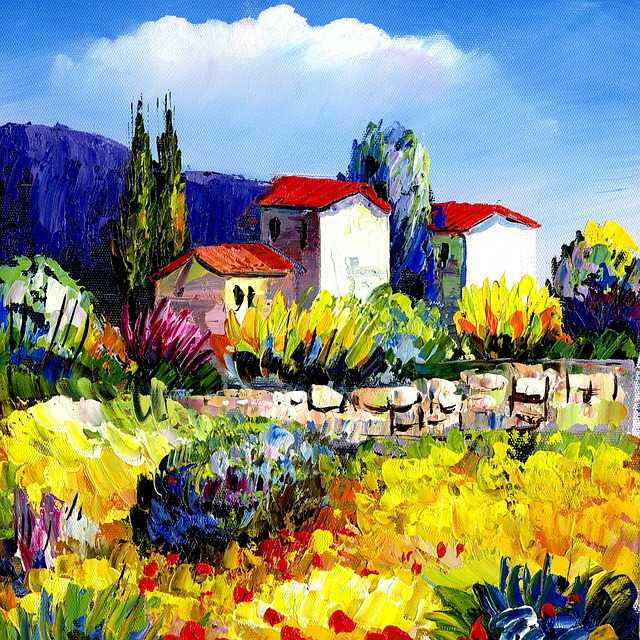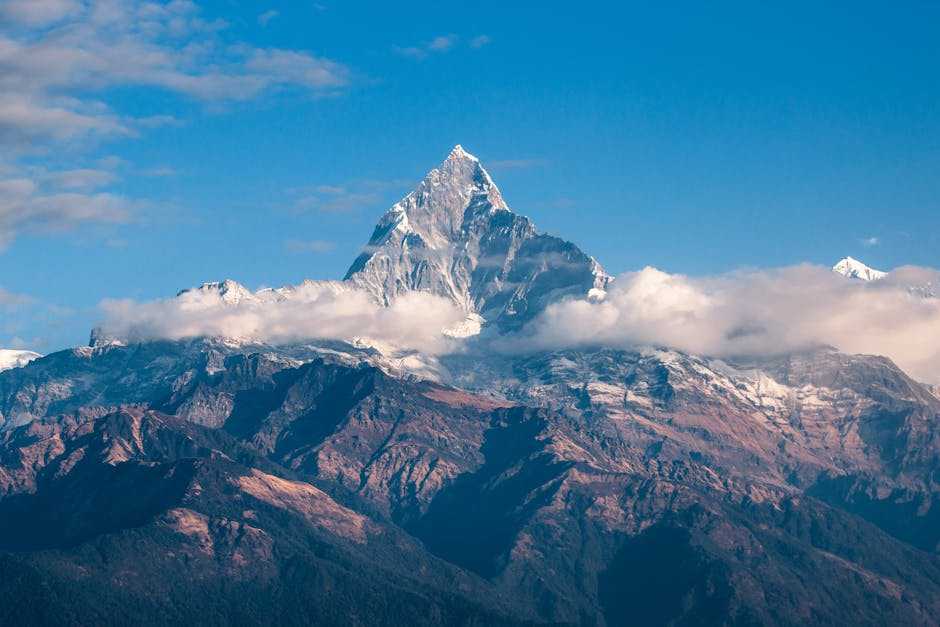Table of Contents
- Exploring the Symbolism of Mountains in Art
- Techniques to Capture Majestic Landscapes on Canvas
- Famous Paintings That Showcase Mountain Beauty
- Tips for Choosing the Right Mountain Artwork for Your Space
- Q&A
- Concluding Remarks
Exploring the Symbolism of Mountains in Art
Mountains have long served as powerful symbols in art, reflecting the dualities of nature and existence. Their towering presence often embodies strength, permanence, and the sublime. For artists, these natural giants represent both a literal and metaphorical ascent—inviting viewers to engage with themes of aspiration and achievement. Paintings featuring mountainous landscapes can be seen as expressions of humanity’s struggle against the vastness of nature, invoking emotions ranging from awe to introspection.
Throughout various artistic movements, mountains have been depicted in diverse styles, each bringing a unique interpretation to this formidable element of nature. In the Romantic era, for instance, artists like Caspar David Friedrich used the ruggedness of mountains to evoke feelings of the sublime, portraying them as majestic and almost otherworldly. Meanwhile, the Impressionists often captured the fleeting effects of light and color on mountainous terrains, emphasizing the beauty and transience of natural landscapes.
Additionally, the symbolism of mountains extends beyond mere aesthetics. They can represent obstacles in the journey of life, mirroring the challenges individuals face. In the realm of contemporary art, some artists incorporate mountains to explore themes of environmentalism and climate change, urging viewers to reflect on humanity’s relationship with nature. This layered symbolism prompts discussions about stewardship and the responsibility we hold towards our planet.
To further illustrate the varied meanings mountains hold in art, the following table showcases notable artists, their famous mountain paintings, and the key themes they explored:
| Artist | Artwork | Themes |
|---|---|---|
| Caspar David Friedrich | The Monk by the Sea | The Sublime, Isolation |
| Claude Monet | Snow Effect, Sunset | Transience, Light |
| Ansel Adams | The Tetons and Snake River | Environmentalism, Nature’s Majesty |
| Georgia O’Keeffe | Black Mesa Landscape | Identity, Landscape Perception |


Techniques to Capture Majestic Landscapes on Canvas
When it comes to translating the grandeur of mountainous landscapes onto canvas, understanding the interplay of light and shadow is essential. Natural light plays a pivotal role in defining the mood of a painting. Early mornings and late afternoons often cast a golden hue that enhances the peaks and valleys, suggesting depth and dimension. Observing how the sunlight interacts with the contours of the mountains can inspire dramatic contrasts between illuminated areas and shadows, giving the painting an exquisite sense of realism.
Another vital technique is foreground, middle ground, and background layering. This compositional strategy helps create a sense of depth and scale in your artwork. Start by selecting a detailed element for the foreground, such as trees or rocks, to anchor the scene. The middle ground can include the mountains themselves, perhaps with clouds or atmospheric elements, while the background may consist of a horizon line. This layering not only draws viewers into the painting but also directs their eyes toward the majestic peaks and portrays them in all their glory.
Color selection is key to depicting majestic landscapes accurately. Mountains often boast a variety of hues depending on their geographical location and the time of day. For instance, rocky outcrops may present earthy browns and grays, while lush valleys showcase vibrant greens. Artists can use a limited palette, strategically combining colors to evoke an emotional response. Consider creating a color chart to experiment with different shades, then apply them strategically in your landscapes to capture the essence of the mountains.
| Technique | Description | Tools |
|---|---|---|
| Light and Shadow | Utilizing natural light to enhance dimension | Brushes, sponges |
| Layering | Creating depth through composition | Canvas, acrylics/oils |
| Color Selection | Choosing hues to reflect the landscape | Color wheel, palettes |
Lastly, immersing yourself in the natural environment can be profoundly inspiring. Consider spending time in the mountains, hiking, or simply soaking in the scenery. Sketching or taking photographs during these excursions can provide reference points for details you may want to include in your artwork. Engaging with nature gives you the chance to observe subtle changes in colors, formations, and textures, enriching your canvas with authenticity and a personal touch.


Famous Paintings That Showcase Mountain Beauty
Throughout art history, mountains have served as a profound source of inspiration, inviting artists to capture their majestic presence on canvas. One iconic example is “The Oxbow” by Thomas Cole, which juxtaposes a serene valley against looming mountains, artistically reflecting the tension between civilization and the untamed wilderness. Cole’s Romantic interpretation invites viewers to contemplate the power of nature, beautifully showcasing how mountains can embody both beauty and grandeur.
In the realm of Impressionism, “Mont Sainte-Victoire” painted by Paul Cézanne stands out as a vibrant homage to the landscapes of his native Provence. The various hues and broken brushwork depict the mountain with a sense of immediacy and emotional resonance. Cézanne’s repeated explorations of this landmark reveal his dedication to capturing the essence of the mountain in relation to the changing light and atmosphere, making it a staple of art that illustrates the subtle complexities inherent in mountain beauty.
Another celebrated work, “The Rocky Mountains, Lander’s Peak” by Albert Bierstadt, showcases the grandeur of the American West. Known for his expansive landscapes, Bierstadt utilized dramatic lighting and sharp details to immerse viewers in a breathtaking wilderness experience. The towering peaks and reflective waters make it a quintessential example of how mountains can inspire awe and a deep appreciation for nature’s raw magnificence.
Lastly, “Mount Fuji” by Katsushika Hokusai, from his renowned series Thirty-six Views of Mount Fuji, emphasizes the cultural significance of mountains in Japanese art. Hokusai’s depiction—often featuring the iconic peak framed by serene landscapes and dynamic weather—serves not only as a representation of physical beauty but also as a spiritual beacon in the lives of the people. This piece embodies the deep connection between culture and the natural world, illustrating how mountains can transcend mere aesthetics to become symbols of identity and inspiration.


Tips for Choosing the Right Mountain Artwork for Your Space
Choosing mountain artwork for your space can dramatically enhance the atmosphere, evoking feelings of adventure and serenity. When selecting a piece, consider the color palette of the room. Artwork featuring bold blues and deep greens can create a tranquil effect, perfect for a calm retreat. Conversely, warm oranges and earthy browns can inject energy and coziness. Identify the dominant hues in your decor, and let them guide your selection to ensure harmony and balance in the room.
Next, think about the style of the artwork. Mountains can be depicted in numerous ways, from realistic landscape paintings to abstract interpretations. If your decor leans towards modern, consider choosing abstract mountain art that uses geometric shapes or unique compositions. For a traditional room, a classic landscape painting with clear details of the mountains is an excellent choice. It’s essential to ensure that the style of the artwork complements the overall aesthetic of your space.
Don’t forget to consider the size of the artwork. A large, commanding piece can serve as a stunning focal point, ideal for a living room or hallway. On the other hand, smaller artworks can create a gallery wall effect, allowing for multiple pieces that tell a story. When deciding on size, also keep in mind the dimensions of the wall where the artwork will be displayed. Use the following simple guidelines to help with your selection:
| Wall Size | Recommended Artwork Size |
|---|---|
| Small (up to 3ft width) | 12×16 inches / 16×20 inches |
| Medium (3ft to 6ft width) | 24×36 inches / 30×40 inches |
| Large (over 6ft width) | 40×60 inches / 48×72 inches |
consider the emotional impact of the mountain artwork you choose. Different pieces can evoke various feelings—some may inspire, while others may provide a sense of calm and introspection. Reflect on what vibe you’re hoping to cultivate in the space, whether it’s energizing or soothing. Additionally, don’t shy away from artworks that tell a story or hold personal significance, as these can deepen your connection to the piece and enhance the ambiance of your environment.
Q&A
Q&A: Mountains in Paintings
Q1: What is the significance of mountains in paintings? A: Mountains have long been a powerful symbol in art. They often represent stability, majesty, and the grandeur of nature. In paintings, mountains can evoke feelings of awe and inspire reflection on humanity’s place within the natural world. Different cultures also imbue mountains with spiritual significance, making them fertile ground for artistic expression.Q2: How have different art movements portrayed mountains? A: Various art movements have approached mountains differently. For instance, the Romantic period emphasized emotional experience and sublime beauty, often capturing mountains as foreboding and awe-inspiring visuals. In contrast, Impressionist artists like Claude Monet presented mountains with softer hues and more fluid forms, focusing on light and atmosphere. Modern artists may abstract or stylize mountains to explore concepts beyond their physical presence, highlighting form, color, and emotion.
Q3: Who are some famous artists known for their mountain paintings? A: Several artists are renowned for their depictions of mountains. Caspar David Friedrich, with his dramatic landscapes, captures the spiritual context of mountainous terrain. Ansel Adams masterfully portrayed American landscapes, turning mountains into iconic subjects through black-and-white photography. More recently, artists like Olafur Eliasson use installation art to explore the themes of nature and mountains, blending environmental consciousness with vibrant aesthetics.
Q4: How do mountains influence the composition of a painting? A: Mountains often serve as formidable focal points in a painting, guiding the viewer’s eye. Their sheer scale can dominate the canvas, creating depth and contrast with surrounding elements. Artists may utilize the leading lines created by mountain ridges to draw attention to key subjects or to create a sense of balance and harmony within the composition. Additionally, the use of color and light on mountains can enhance the overall mood of the work, making them a crucial element in visual storytelling.
Q5: What emotions do mountains evoke in viewers? A: Mountains can evoke a wide range of emotions, from serenity and peace to isolation and grandeur. The immensity of mountains can instill feelings of insignificance or contemplation about life’s larger questions. Additionally, paintings featuring mountains may stir a sense of adventure or nostalgia, as they often remind viewers of personal experiences in nature or aspirations for exploration.
Q6: Can mountains in paintings influence environmental consciousness? A: Absolutely! Art has the power to raise awareness about environmental issues, and paintings of mountains can be particularly impactful. By depicting the beauty and majesty of mountainous landscapes, artists inspire viewers to appreciate and protect these natural wonders. This connection often stimulates conversations about conservation, climate change, and the significance of preserving our planet’s diverse ecosystems.
Q7: How can contemporary artists use mountains in their work? A: Contemporary artists have the flexibility to use mountains in innovative ways, whether through realism, abstraction, or mixed media. They might explore themes of climate change by highlighting the impact of melting glaciers, use technology to create interactive installations focused on mountain environments, or even comment on the human experience and its disconnection from nature. The key is in the fresh perspective and context they provide, breathing new life into a long-standing motif in art.
This Q&A serves to delve deeper into the many facets of mountains as a subject in paintings, revealing their artistic relevance, emotional impact, and cultural significance.
